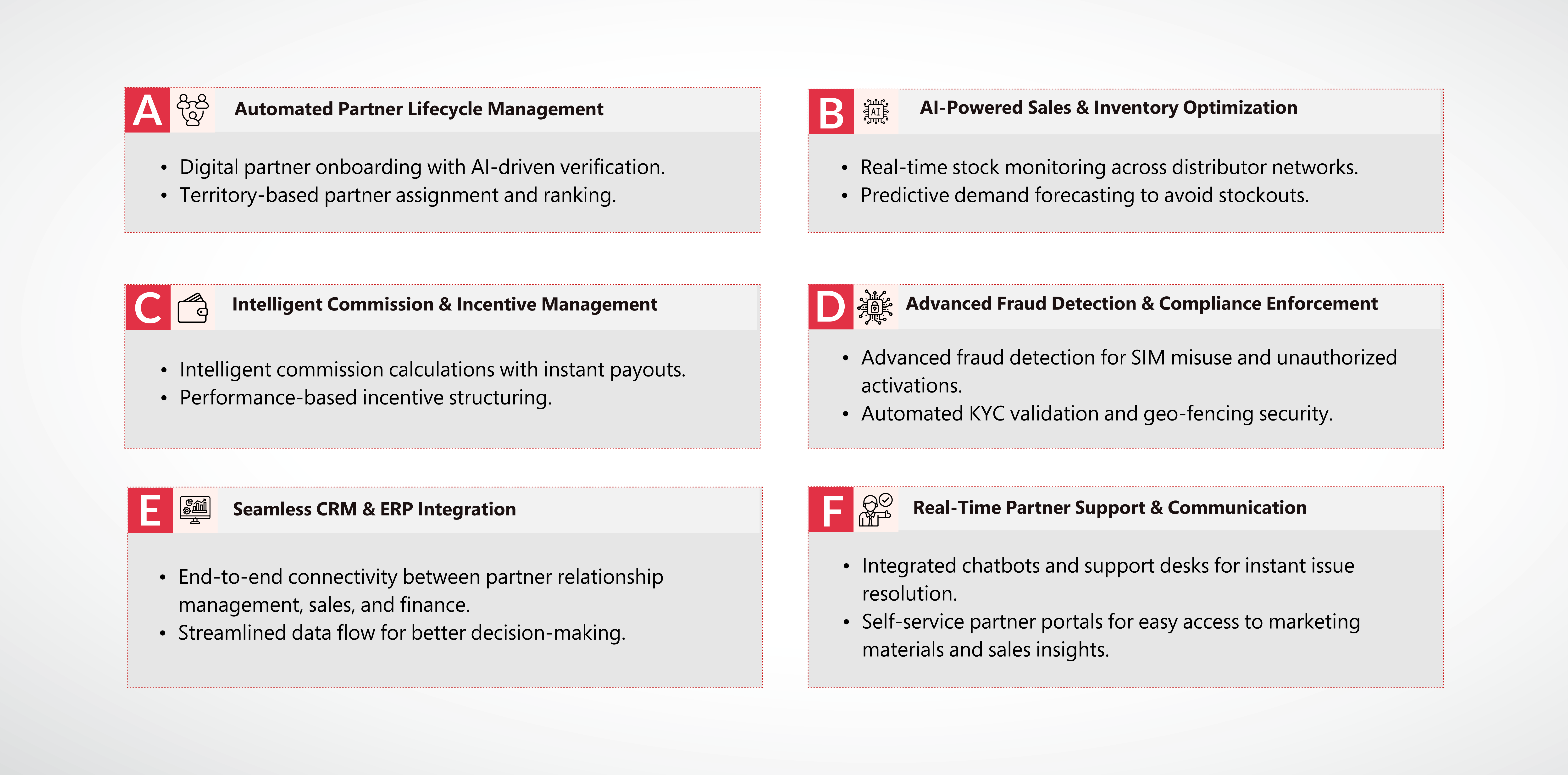Introduction
The telecom industry is undergoing a significant transformation, driven by digitalization, evolving business models, and the increasing need for seamless connectivity. To remain competitive, telecom operators must foster strong, strategic relationships with their partners—distributors, resellers, retailers, and service providers. Effective partner relationship management (PRM) is no longer just a necessity but a differentiator that defines market leadership.
This white paper explores the best practices in partner relationship management, delving into strategies that enhance collaboration, drive revenue, and ensure operational excellence. Additionally, it highlights emerging trends in PRM systems, offering insights into how cutting-edge technology is reshaping partner engagement and strengthening best practices.
Best Practices in Partner Relationship Management for Telecom
Telecom operators must adopt a proactive and strategic approach to managing their partner ecosystems. A well-defined partner strategy, coupled with robust execution, ensures business continuity, revenue growth, and enhanced market coverage. Here are the best practices in partner relationship management for telecom providers.
Seamless Partner Onboarding & Profiling
A frictionless onboarding experience is critical in setting the foundation for long-term collaboration. Telecom operators should implement a structured onboarding framework that includes partner verification, role-based categorization, and training programs. By ensuring clear expectations and well-defined operational guidelines from the outset, operators can streamline partner engagement, reduce compliance risks, and accelerate time-to-market.
Transparent Commission & Revenue Sharing Models
Strong partnerships are built on trust and transparency. Defining clear commission structures, incentive plans, and revenue-sharing mechanisms is essential to maintaining partner confidence and driving mutual growth. Real-time commission tracking, data-driven performance evaluations, and incentive alignment with business goals encourage partners to focus on high-value customer acquisitions and retention efforts.
Efficient Order & Inventory Management
Maintaining optimal stock levels and ensuring timely product availability are critical in telecom distribution networks. Operators should establish an integrated order and inventory management framework that provides partners with real-time access to product availability, order tracking, and demand forecasting insights. Streamlining logistics processes minimizes disruptions, improves service levels, and enhances overall supply chain efficiency.
Performance Monitoring & Sales Optimization
To drive business growth, telecom operators must continuously monitor partner performance, track key sales metrics, and identify areas for improvement. Establishing a structured performance review process allows operators to assess partner contributions, recognize high-performing partners, and provide targeted support where needed. Data-driven insights enable telecom companies to refine go-to-market strategies and strengthen their competitive positioning.
Fraud Prevention & Compliance Monitoring
Regulatory compliance and fraud prevention are top priorities in telecom partner management. Operators must enforce stringent Know Your Customer (KYC) protocols, monitor partner transactions for anomalies, and deploy fraud detection mechanisms to safeguard their business. A proactive approach to compliance ensures adherence to regulatory mandates, mitigates financial risks, and upholds brand integrity.
Marketing & Partner Engagement Support
Successful telecom operators view their partners as an extension of their brand and invest in collaborative marketing initiatives. Joint marketing campaigns, co-branding opportunities, and tailored promotional incentives help partners effectively position telecom products and services. Providing marketing assets, lead generation support, and digital engagement tools strengthens partner relationships and enhances customer acquisition efforts.
Communication & Partner Support
Seamless communication is fundamental to effective partner relationship management. Telecom operators must establish clear communication channels, provide partners with dedicated account managers, and facilitate ongoing training and knowledge sharing. Regular engagement through forums, webinars, and advisory councils fosters an open exchange of ideas, ensuring alignment on business goals and customer needs.
Scalability & Expansion Planning
As telecom markets evolve, operators must be prepared to scale their partner ecosystems efficiently. Expansion planning should include market opportunity analysis, the identification of new partner segments, and the adoption of scalable operational frameworks. By leveraging data-driven insights, telecom companies can strategically grow their partnerships while maintaining high service quality and operational efficiency.
Emerging Trends in Partner Relationship Management Systems for Telecom
The latest advancements in PRM systems are not only reshaping partner engagement but also reinforcing best practices in telecom partner management. By integrating AI-driven automation, mobile-first accessibility, and enhanced analytics, PRM systems are becoming the backbone of modern partner ecosystems. These trends ensure that telecom operators can scale efficiently, optimize revenue-sharing models, and prevent fraud while maintaining strong partnerships. Below are some of the key trends that are enhancing best practices in PRM systems.
AI-Driven Predictive Analytics
- AI-powered insights enable telecom operators to forecast market demand, optimize inventory, and anticipate partner performance trends.
- Machine learning algorithms can help in proactive decision-making, reducing revenue leakage and optimizing resource allocation.
- AI ensures continuous performance tracking, identifying opportunities for growth and potential risks in real time.
Integration with CRM & ERP Systems
- Seamless integration between PRM systems and enterprise platforms such as Customer Relationship Management (CRM) and Enterprise Resource Planning (ERP) enhances visibility across sales and operations.
- Automated workflows improve partner engagement and operational efficiency, ensuring data consistency across multiple systems.
- Integrated systems enhance scalability by reducing redundancies and providing holistic partner performance insights.
Real-Time Commission & Incentive Calculation
- Dynamic, real-time tracking of partner commissions fosters transparency and minimizes disputes.
- AI-driven incentive structures adapt based on partner contributions, ensuring fair and performance-based rewards.
- Continuous incentive optimization encourages partner engagement and aligns efforts with business growth objectives.
Mobile-First Partner Engagement
- The adoption of mobile-enabled PRM applications allows partners to manage orders, track earnings, and access support services on the go.
- Mobile-driven solutions enable faster decision-making and increase partner productivity, leading to improved business agility.
AI-Based Fraud Prevention & KYC Compliance
- Automated KYC verification and AI-driven fraud detection mitigate risks related to fraudulent activations and unauthorized transactions.
- Geo-fencing ensures that partners operate within their assigned territories, reducing compliance violations.
- AI-powered fraud monitoring enhances regulatory adherence, reducing financial and operational risks.
Digital Partner Portals for Self-Service
- Centralized partner portals empower distributors and resellers with self-service capabilities for resource access, performance tracking, and training.
- Automated workflows improve efficiency and reduce administrative burdens, allowing partners to access the tools they need instantly.
- Partner portals enhance engagement by providing a structured hub for training, marketing materials, and support resources.
Comviva BlueMarble Retail: Next-Generation Partner Relationship Management for Telecom
Comviva’s BlueMarble Retail is an industry-leading Partner Relationship Management System (PRMS) that enables telecom operators to optimize their partner ecosystems. By leveraging the latest advancements in AI, automation, and analytics, BlueMarble Retail enhances partner engagement, streamlines operations, and fosters business growth.
 Conclusion
Conclusion
The telecom industry must evolve to manage complex partner networks effectively. Best practices in partner relationship management ensure transparency, efficiency, and scalability, while next-gen Partner Relationship Management Systems (PRMS) leverage AI, automation, and real-time analytics to optimize operations.
Comviva’s BlueMarble Retail provides a future-ready, AI-driven partner relationship management system that enables telecom operators to:
- Automate onboarding, revenue tracking, and compliance enforcement.
- Enhance partner engagement through real-time insights and communication tools.
- Reduce fraud risks with advanced AI-based security mechanisms.
With its innovative capabilities, Comviva’s BlueMarble Retail empowers telecom operators to scale their partner ecosystems efficiently and maintain a competitive edge in an evolving market.


 Conclusion
Conclusion



